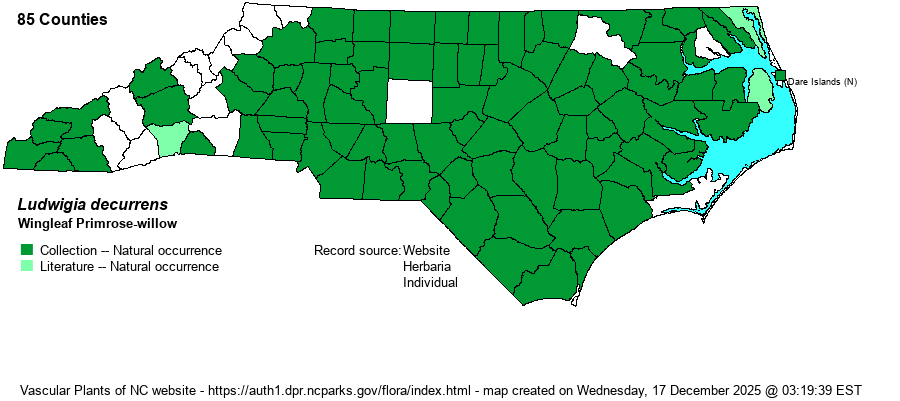| Author | Walter | |
| Distribution | Throughout the Coastal Plain and Piedmont; scattered in the Mountains, found mainly in the southwestern third of the province, and seemingly absent from the northern counties.
This is a widespread Southern species, raging from southeastern PA and OK, south to southern FL and central TX. | |
| Abundance | Common in the Coastal Plain, except scarce along the immediate coast from Carteret County north to the VA line. Fairly common to frequent in the Piedmont, and infrequent to fairly common in the southwestern Mountains. Very rare to rare in most of the Mountains and foothills. Though recorded from nearly all of the Coastal Plain and Piedmont counties, it is clearly much less numerous than is L. alternifolia, which has a similar range. | |
| Habitat | This species grows in wet places, generally in swamp openings, marshes, pond margins, large ditches, and other quite wet and somewhat rich-soil/mud places. | |
| Phenology | Blooms from June to October, and fruits shortly after flowering. | |
| Identification | This is a rather robust herb, growing erect to 3-3.5 feet tall, with a distinctly winged (lengthwise), 4-angled stem. The wings are basically extensions of the leaf bases, as the alternate leaves are otherwise sessile. Each blade is lanceolate, about 5 inches long and 1-inch wide -- larger than in most other members of the genus. The flowers are in leaf axils, usually with 4 fairly large (for the genus) and rounded bright yellow petals, though occasional flowers can have up to 7 petals. The spread flower is about 4/5-inch across. Though the very common L. alternifolia can look fairly similar, with 4 large yellow petals in axils, the stems are quite different. That species can have some wings on the stem angles, but in L. decurrens, the base of each leaf has a wing extending below it far down the stem; thus, the stem contains two very distinct wings. You should not have much trouble finding this distinctive species downstate in a variety of wetland habitats. | |
| Taxonomic Comments | This and several other species (generally those with 8 stamens) were formerly placed in the genus Jussiaea.
| |
| Other Common Name(s) | Wingstem Primrose-willow, Wingleaf Primrose | |
| State Rank | S5 | |
| Global Rank | G5 | |
| State Status | | |
| US Status | | |
| USACE-agcp | OBL link |
| USACE-emp | OBL link |

